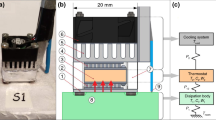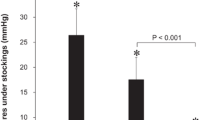Abstract
A well defined step compression was applied over an area of the skin and maintained for a fixed time. The resistive force of the tissue, which was continuously recorded, decreased with time as a function of the translocation of fluid volume to the surrounding areas. The rate of decrease was proportional to the fluid mobility. Measurements on ten normal subjects and 14 oedematous patients showed marked differences in the pattern of fluid translocation. Flow rate and total volume flow under compression were calculated and found to vary with the degree of oedema. This noninvasive technique can measure the degree of oedema, which provides important information for diagnosis and treatment.
Similar content being viewed by others
Abbreviations
- V(t) :
-
volume of translocated fluid in timet
- F(t) :
-
tissue resistive force to deformation
- h :
-
compression depth
- A :
-
surface area
- k :
-
spring constant
References
Aukland, K. (1973) Autoregulation of interstitial fluid volume: oedema preventing mechanisms.Scand. J. Clin. Lab. Invest.,31, 247–254.
Brace, A. R. andGuyton, A. C. (1979) Interstitial fluid pressure: capsule, free fluid, gel fluid, and gel absorption pressure in subcutaneous tissue.Microvasc. Res.,18, 217–228.
Brody, G. S., Peng, T. J. andLandel, R. F. (1981) The rheological properties of human skin and scar tissues. InBioengineering and the skin. (Marks, R. andPayne, P. A. (Eds.) Int. Med. Publ., Lancaster, UK, 147–158.
Broman, S. andWigertz O. (1971) Transient dynamics of ventilation and heart rate with step changes in work load from different load levels.Acta Physiol. Scand.,81, 71–73.
Dick, J. C. (1951) The tension and resistance to stretching of human skin and other membranes, with results from a series of normal and oedematous cases.J. Physiol.,112, 102–113.
Finly, J. B. (1978) Thixotropy in human skin.J. Biomech.,11, 333–342.
Guyton, A. C. (1965) Interstitial fluid pressure II Pressurevolume curve of interstitial space.Circ. Res.,16, 452–460.
Guyton, A. C. (1971)Textbook of medical physiology. Saunders, Philadephia, USA, 241–251.
Guyton, A. C., Granger, H. J. andTaylor, A. E. (1971) Interstitial fluid pressure.Physiol. Rev.,51, 527–563.
Hickman, E., Lindan, O., Reswick, J. B. andScanlan, R. H. (1966) Deformation and flow in compressed skin tissues. Biomed. Fluid Mech. Symp. Proc., ASME, Denver.
Mridha, M. andÖdman, S. (1984) Mechanical wave transmission in subscutaneous oedema. XLI Läkaresällskapets Riksstämma, Stockholm, MTF 5.
Mridha, M. andÖdman, S. (1985) Characterization of odedema by mechanical impedance measurement.J. Invest. Dermatol.,85, 576–578.
Potts, R. O., Buras, E. M. andChrisman, D. A. (1984) Changes with age in moisture content of human skin.,82, 97–100.
Schade, H. (1926) Gewebselastometrie klinichem und allgemeinärztlichen XGebrauch.Munch. Med. Wschr.,153, 2241–2246.
Schwartz, A. B. (1916) The clinical study of oedema by means of elastometer.Arch. Internal Med.,17, 396–403.
Sodeman, M. A. andBurch, G. E. (1938) A direct method for the estimation of skin distensibility with its application to the study of vascular states.J. Clin. Invest.,17, 785–793.
Steinmetz, M. A. andAdams, T. (1981) Epidermal water and electrolyte content and the thermal, electrical and mechanical properties of skin. InBioengineering and the skin,Marks,R. andPayne,P. A. (Eds.) Int., Med. Publ., Lancaster, UK, 197–213.
Stranden, E. andEnge, I. (1982) Computed tomography in the investigation of leg oedema following arterial reconstructions,Europ. J. Radiol.,2, 113–116.
Tregear, R. T. (1966)Physical functions of skin. Academic Press, London, 72–95.
Author information
Authors and Affiliations
Rights and permissions
About this article
Cite this article
Mridha, M., Ödman, S. Noninvasive method for the assessment of subcutaneous oedema. Med. Biol. Eng. Comput. 24, 393–398 (1986). https://doi.org/10.1007/BF02442694
Received:
Accepted:
Issue Date:
DOI: https://doi.org/10.1007/BF02442694




